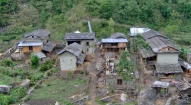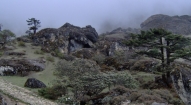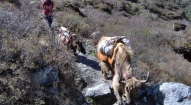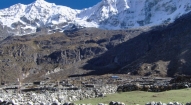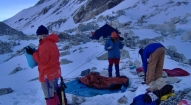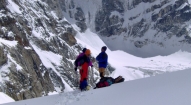- Home |
- Why With Us |
- About Us |
- Booking |
- Contact Us |
- Site Map


Numbur Cheese Circuit (NCC)
Days from
Ramechhap, only 100km east from Kathmandu, offers a trekking experience unequalled in Nepal. Sandwiched between the high Himalayan range to the north and the rolling Maharbhata range to the south, trekking in Ramechhap offers magnificent Himalayan panoramas, lush rhododendron forests, and unique cultural experiences. The elevation ranges from 488m at the Sun Kosi River to Numburchuili peak along Everest Himal range at 6959m. Vistas of the rolling foothills dotted with isolated farming communities, rhododendron forests and bamboo groves, all crowned by an array of snow peaks are bound to leave you breathless. The cultural rituals surrounding Buddhism and Hinduism are another major attraction. But the foremost prize of the whole experience is the chance to meet people from 21 different Indigenous communities, learn about them and their culture- yes, all of the above in one trek. You will feel good knowing that your visit is genuinely helping your hosts. And what’s more, you can relax on one of the best beaches in Nepal!!
| Max. Elevation : | Grade : |
| Best season : | Type of trek : |
| Duration : | Starting point : |
| Ending point : | Highlights : |
Ramechhap, only 100km east from Kathmandu, offers a trekking experience unequalled in Nepal. Sandwiched between the high Himalayan range to the north and the rolling Maharbhata range to the south, trekking in Ramechhap offers magnificent Himalayan panoramas, lush rhododendron forests, and unique cultural experiences. The elevation ranges from 488m at the Sun Kosi River to Numburchuili peak along Everest Himal range at 6959m. Vistas of the rolling foothills dotted with isolated farming communities, rhododendron forests and bamboo groves, all crowned by an array of snow peaks are bound to leave you breathless. The cultural rituals surrounding Buddhism and Hinduism are another major attraction. But the foremost prize of the whole experience is the chance to meet people from 21 different Indigenous communities, learn about them and their culture- yes, all of the above in one trek. You will feel good knowing that your visit is genuinely helping your hosts. And what’s more, you can relax on one of the best beaches in Nepal!!
The real Ramechhap can be explored through the recently developed two new trails (i) 7/8 Days ‘Indigenous Peoples Trail’ in the west and (ii) the 14 to 16 Days ‘Numbur Cheese Circuit’ in north Ramechhap. Efforts for developing two new trails in the district was coordinated by the Local Economic Development (LED) Forum Ramechhap with the active leadership of District Development Committee (DDC) Ramechhap and the Ramechhap Chamber of Commerce and Industry (RCCI) along with the technical and financial support from International Labor Organization/Employment and Peace Building based on Local Economic Development (ILO/EmPLED). The promotional efforts are undertaking jointly with the Nepal Tourism Board (NTB), Trekking Agencies Association of Nepal (TAAN) and Trekking Agencies in Nepal.
If you want to escape the congestion of commercialized trekking trails and get ‘off-the-beaten track’ then plan your trek to the recently developed trekking route, the ‘Numbur Cheese Circuit (NCC)’. Located in Ramechhap, around 190 km east of the capital city Kathmandu, the NCC is a 14 to 16 days circuit trail connecting two beautiful river valleys, namely the Khimti and Likhu in the lap of Everest and Rolwaling region.
The trail has been named in honor of the yet unclimbed peak Numburchuli (6959m) as well as for as well as for one of Nepal’s first yak cheese factories established in 1957. NCC offers visitors the superb and breathtaking views of majestic Himalayan peaks including Everest range, Numburchuli, Gaurishankar, Jugal and Langtang Himal ranges, pristine nature and unspoiled culture. NCC is mostly an eco-lodge camping trek in addition to the unique home-stay experience among Sherpa communities. NCC welcomes both domestic and international visitors.
The trek encompasses a variety of terrain- deep river gorges, glacial lakes, terraced rice fields, temperate to alpine vegetation, and Sherpa villages to the towering peaks of Bigphera Go Nup (Pathibara) and Numburchuli. One can also observe Yak Cheese factories and the famous Thodung Monastery on the way. In March and April, rhododendrons bloom in profusion and eagles, musk deer and Himalayan Tahr are a regular sighting! And with a lot of luck, you can catch a glimpse of the elusive snow leopard .
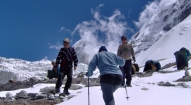
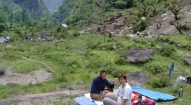
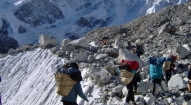
Suggested Itineraries
Primarily designed for eco-camping experience, the NCC is a 14 to 16 day circuit trek starting at Shivalaya and ending at Those, Ramechhap. Highly experienced and short duration visitors can customize the NCC package to less than and up to 13 days, particularly by skipping overnight stays at Panipakha, Gumdel and Those. Interesting side treks of the ‘Numbur Cheese Trek’ include Baula Pokhari, the isolated valley of Khola Cire, and the natural Buddhist shrine at Kau Chorten near Ngeju. NCC could also be a strategic launch for an adventure trek to Rolwaling region via Likhu Nup glacier and to the Everest region via Kalla Pass below the Ngeju Kharka. Besides these itineraries, various customized packages can also be developed as per the interest and time of the visitor. This trek is a real expedition into a wilderness area, with strategically located eco-camping sites. The trek can also be done in reverse.
Detailed – day by day Itinerary:
Day 01: Kathmandu- Shivalaya
An 8-9 hours drive from the capital city Kathmandu brings you to Shivalaya, the gateway to the Everest region as well as the NCC. Shivalya lies on the Khimti Khola River valley withlodges and a trek info center.
Shivalaya has a busy and well-stocked bazzar for trekking supplies. Enjoy a cold river-cooled beer and yak cheese on the lodge verandahs before beginning the trek. The trail from Jiri to Shivalaya on the other hand is part of the classic Sir Edmund Hillary route to Everest.
Day 02: Shivalaya-Khahare
Day two is a leisurely four-hour trek northwards along the Kimti Koala River to Khahare village. Just beyond Shivalaya, the valley opens up to allow views of the first snow-capped peaks of the Rowaling Himal Range, whose visibility becomes crystal clear in the next 6 to 7 days. The trail runs up and down through terraced fields, crisscrosses the river and then snakes steeply up a cliff.
Khahare village comprises of less than 5 houses, inhabited only during the winter by herders who spend their summer on higher pastures tending their Yaks. Enjoy your night at a home-stay with a Sherpa family and taste a variety of dishes made of Yak cheese, potato and barley.
Day 03: Khahare –Panipakha (3-4 Hours)
Be prepared for an adventurous trek and eco-camping ahead. Enjoy wilderness trekking along the Khimti River and at Panipakha find your first eco-camping site amidst scattered yak/chauri sheds and towering pines. Enjoy majestic sunset views from Panipakha.
Day 4: Panipacka- Maanedanda (3-4 Hours)
Continue to snake your way up as the trail ascends through conifer and rhododendron forest before leveling out in the summer pastures of Maanedanda. A flattened ridge, Maanedanda offers spectacular views of thick green jungle carved by numerous steep waterfalls on both sides.
Day 05: Manedanda- Jatapokhari & Panchpokhari
Next the trail makes a climb towards Jatapokhari and as altitude increases, the alpine pastures give way to scrubby forests of Sunpati, a rare mountain herb. The path by the river reaches a dramatic waterfall that signifies their arrival at Jatapokhari, a holy mountain lake perched in the lap of Panchpokhari Danda. The lake is a popular pilgrimage destination where over 3000 pilgrims gather to celebrate Janaipurnima (during August) every year. It is believed that taking a dip in its holy water will fulfill one’s wishes.
An overnight stay here is recommended to allow for acclimatization. Take a side trip to Baula Pokhari or “Mad Lake” but don’t disturb the spirits within or your wishes may not come true! In sum, there are five small lakes, known collectively as Panchpokhari, within this huge glacial cirque regarded as precious high altitude wetlands. Sunset views of the mountain peaks of Numbur and Parchemo arenot to be missed from here. Enjoy camping accommodation at Jatapokhari.
Day 6 And 7: Panchpokhari-Tare & Around Khola Seer
The morning trek will be a challenging one as you cross over the Panchpokhari Pass at 4,605m and climb up to the base camp of Bigphera Go Nup (Pathibhara). This is followed by a glacier river walk to Tare. The Panch Pokhari pass offers spectacular panoramic views of the Rolwaling, Numbur and Everest ranges. The trail and views of the Himalayan peaks, glaciated valleys and folded hills to the south are breathtaking. Enjoy the scenic landscape at Kholakharka or do some rock climbing. Interested visitors can make their overnight stay even at Kholakharka.
Over the white river (Nupche) cross the yak pasture and enjoy fresh cheese. Observe the golden Bigphera Go Nup (Pathivara) during sunset before setting into a wilderness camp. For anyone with an extra day, a side trip to Bigphera Go Nup base camp and glacier, Khola Seer (4469m) and Linkhu Nup glacier is worthwhile. Plan your trek wisely to visit beautiful Luikharka, Linkhu Nup Glacier, Bigphera Go Nup glacier and Panga Dinga glacier. If you are lucky enough, you will see Himalayan tahr, and even snow leopard.
Go up to the base camp or see the up-close view of Ramdung, Chukyima Go and Bigphera Go Nup. Horses can be rented during the grazing season to take you further up the pastures and into Khola Seer where the impressive Lhasa Lake (4469m) remains hidden. This vast, remote lake boasts an amazing Tibetan panoramic backdrop that is sure to leave a lasting impression.
Days 08 And 09: Tare- Rhakidanda-Ngeju
The most strenuous section of the Numbur Cheese Circuit, specifically the trail from Tare to the Likhu Khola valley is one that is both challenging as well as rewarding. The mountain views extending north into
Tibet as you cross the Gyajo La (Thulo Lapcha) at 4880m, traditionally used by local Sherpas to bring yaks across the mountains, are sensational. A gradual decent to Thulo Lapcha brings you to the seasonal Kharkas of Lakhedanda (4315m) in the Likhu Khola valley.
“Wilderness” is the only apt term for the wild and rugged basin of the Lhiku River valley where you might even catch a glimpse of the elusive snow leopard. From Lakhedanda take in striking views of Dudkpokhari or ‘Milky Lake’ surrounded by tumbling glaciers like Surmoche and Likhu glacier and large moraines.
The trek down from the Likhu glacier follows the turbulent Likhu Khola River until you reach the remote yak pastures of Ngeju (3690m) nestled by the river. Here you`ll find two more cheese factories and numerous chauri sheds dotted alongside the river.
A short side trip up from Ngeju is the ancient Buddhist Shrine of Kau Gumba lying above the tree-line in the upper Likhu Khola Valley enclosed by a great sweep of high rock and snow peaks.
Day 10: Ngeju-Lahchhewar
From Ngeju the trail weaves through thick ancient forests alongside the Likhu Khola re-emerging into the remote civilization of Sherpas in Lhachhewar. Lahchhewar ‘often called Chhewar’ is one of the most beautiful Sherpa villages in the upper Ramechhap region, with astonishing landscapes, cultural wealth, and hospitable Sherpa people. ‘Chhewar’ offers unspoiled Sherpa culture where people still maintain their traditional way of life.
Enjoy again the Sherpa culture with home-stay accommodation.
Day 11: Lhachhewar-Kyama
The trail follows the Likhu Khola River valley, descending through deep forest to Kyama with good views of Bigphera Go Nup and Numburchuli. Just at the confluence of Likhu and Nupche River, you will find Uma- Tirtha temple, widely regarded as Kashi of the Himalayas.
Enjoy the natural chanting sounds of deer and varieties of birds around Kyama. Visit an artistically painted monastery and experience Sherpa home-stay with cultural performance, too.
Day 12: Kyama-Gumdel (2 Hours)
With the glistening Numberchuili as the backdrop, Gumdel is a tiny hamlet gathered around a large Buddhist Stupa. The Gumdel home-stay offers the best of Sherpa hospitality and cultural traditions amidst a luxuriant landscape and spectacular mountain scenery.
Day 13: Gumdel-Serding Or Bhandar (4 to 5 Hours)
From Gumdel, the trail either descends through the mountain terrace along the Likhu River finally meeting the Everest trail at Bhandar or ascends through the dense forest finally reaching the beautiful Serding (3360m). Enjoy densely folded temperate and subalpine forest with a scenic view of Bigphera Go Nup, Numburchuli, and Kalla pass/danda as a backdrop. Enjoy fresh yak cheese in the serene environment of Serding.
At sunrise, don’t miss to see the unique view of Gaurishankar from Serding or from Punnasa view point.
Day 14: Serding/Bhandar- Thodung-Lapchane (4-5 Hours)
Descend gently to observe one of Nepal’s first yak cheese factories, established in 1957 along the way to Thodung. Visit the nearby monastery and get a warm blessing from the lamas. Thodung Monastery is a large, active monastery surrounded by aromatic pines, and a variety of flora that enhance the serenity of the monastery and its surroundings. Have your lunch with lamas at Thodung or stroll back down to Deurali which lies on the Everest trek. You will see a unique vista of Gaurishankar Himal from Ekanagi.
Falamedanda (3105m), thirty minutes before the Newar village of Lapchane, is one of the tallest hills in Ramechhap from where you can see most of the central and eastern Himalayan peaks like Langtang, Gauri Shankar, Numbur and the Everest range. The hilltop also offers breathtaking sunrise and sunset views. The variety of flora and fauna, with 65 species of birds, makes it a fine place for nature lovers. In the evening, enjoy Newari culture and tradition with home stay accommodation at Lapachane.
Day 15: Lapchane-Those (3 Hours)
Enjoy sunrise views from Falamedanda/Tame and gradually descend down on your last day at Those. Before the construction of the Jiri Road, that was the busiest market town on the trade route between Namche and Lamosangu. Sit back and relax by the river and perhaps look through your photos with your guides.
Day 16: Those-Kathmandu
Drive back to Kathmandu through the mountain terrain.
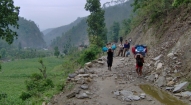
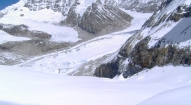
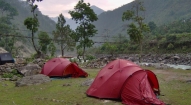
March to June and September to December are the best seasons for trekking in NCC. However, Shivalaya, Serding, Thodung, Gumdel, Deurali and Lapchane areas can be visited with various customized packages throughout the year. Lhosar (During February), Buddha Purnima (During May) and Janaipurnima Festival (Full moon during the end of August) are some important events to observe local culture and traditional rituals.
- Accommodation
NCC is primarily an eco-camping trek. Accommodation on the ‘Numbur Cheese Circuit’ ranges from a few well-established lodges at Those, Shivalaya, Deurali, Serding and Bhandar on the Everest Base Camp route, to newly developed eco-camping sites combined with the family home-stays in magnificent Sherpa and Newari homes.
- Eco-Camping
Without a doubt, one of the many exciting experiences for visitors to NCC is Eco-camping. Visitors can spend 5 to 7 nights at the designated eco-camping sites at Panipakha, Manedanda, Panchpokhari, Tare, and Ngeju. Eco-camping sites are equipped with safe drinking water, kitchen cum porter shelter, dry stone wall and drainage facilities. Visitors need to bring camping gear like tents, sleeping bags, mattresses,
- What is a Home-stay?
Rural Nepalese have a traditional love for meeting people, making new friends and welcoming guests into their homes. In turn, for many tourists as well as visitors to Nepal, there is little that is more interesting than staying as guests in a traditional Nepali home. When staying with a Nepali family guests live the life the way local people do, and enjoy being treated like part of the family.
Home-stays provide an authentic visitor experience that directly improves the lives and heritage of local Communities and aims to discover the real Nepal and to enjoy the untouched and undisturbed country-side. The homes are not hotel-like; instead they reflect the traditional and simple atmosphere of the people. Apart from the pleasure of being amidst peaceful and serene environment, tourists can also enjoy the traditional folk dances and music presented by the local men and women. The focus for the guests is on experiencing and learning from an authentic and enriched culture. Visitors are often involved in local activities that range from cooking classes to attending a traditional wedding, watching a local cultural dance. In addition, the program increasingly responds to the growing interest among urban Nepali to rediscover, taste, appreciate and maintain contact with their rural roots.
Local people organize and host the visitors and therefore are the primary recipients of the benefits, financial and otherwise, that accrue from the tourism activity. In addition to the host families, many of the micro-enterprises in the locality also benefit directly from the influx of tourists and increase demand for their products. The home-stay concept provides the ideal vehicle for visitors to experience the rural and traditional Nepali way of life, and for the local community to participate and benefit directly from tourism. By staying at one of our home-stays a certain percentage of the accommodation price you provide is placed into a community fund to support further community projects as decided by the local village tourism development committee.
Kitchen kits, and all food items and fuel (e.g., kerosene). Experienced porters and trained local guides can help to manage your camping in these wilderness areas.
Home-Stay Accommodation
Home-stay facilities can be enjoyed at Khahare, Lhachhewar, Kyama, Gumdel and Lapchane. Visitors can enjoy the basic accommodation and facilities at the traditionally managed home-stay lodging of the Sherpa and Newar communities. Boiled and filtered drinking water and hygienic toilets are available at all home-stays. Bucket hot shower can be available upon request. Visitors are allowed and expected to observe and participate as well in the traditional activities of Sherpa communities.
Hotel and Lodges
A few well-established lodges are available at Those, Shivalaya, Deurali, and Bhandar. Serding has a few hotels and lodges with basic facilities. Here, you can select items from a simple menu as is common in other popular trekking routes in Nepal. Bucket hot shower can be available upon request.
Other Facilities and Services
- Accessibility
Shivalaya and Those in northern Ramechhap are the starting and finishing points of the Numbur Cheese Circuit located at 8-9 hrs drive from Kathmandu. Super express bus service to Shivalaya can be taken from old Bus Park, near Nepal Tourism Board (6-7am daily). The road is very well paved till the Jiri offering unobstructed fine mountain views. The route follows the Arniko Highway before turning right at Lamosangu for a climb on the Swiss-built Lamosangu-Jiri Road through Sindhupalchowk and Dolakha Districts. Buses often make a lunch stop at Mude Bazaar, famous for the largest potatoes in Nepal.
- Communication
Local landline (STD) is available in all villages except in the remote areas of Panipakka, Maanedanda, Tare, Rhakidanda, and Ngeju. International connections (ISD) are limited to Those, Shivalaya, Deurali, and Bhandar. Internet is still not available in the area so Jiri could be the nearest point for internet access. Mobile telephone facilities are available at Shivalaya, Khahare, Lhachhewar, Kyama, Gumdel, Serding, Deurali, Lapchane and Those. Police posts at Shivalaya and Bhandar can be helpful for any security related arrangement and emergency communication.
- Health Facilities
Local health posts with basic medicine are available at Shivalaya, Garjyang, Bamti Bhandar and Those. Some more advanced facilities can be expected in Jiri hospital on the way.
- Trekking Supplies
Local bazaars selling basic trekking supplies can be found in Shivalaya, Gharjeng, Those, Deurali, and Bhandar. Only a few local markets selling local produce and a limited range of drinks and snacks are available thereafter. As the trail is new, visitors are kindly advised to bring a first aid kit, dried fruit, chocolate and other high energy food along with a hats, light and warm outfits, sunglasses, sun cream and other necessities.
- Trekking Fees
Presently, no any fee should be paid for entering in to the NCC. But, as the area has been recently declared as Gaurishankar Conservation Area (GCA), the Government of Nepal may charge some entry fee after some months.






